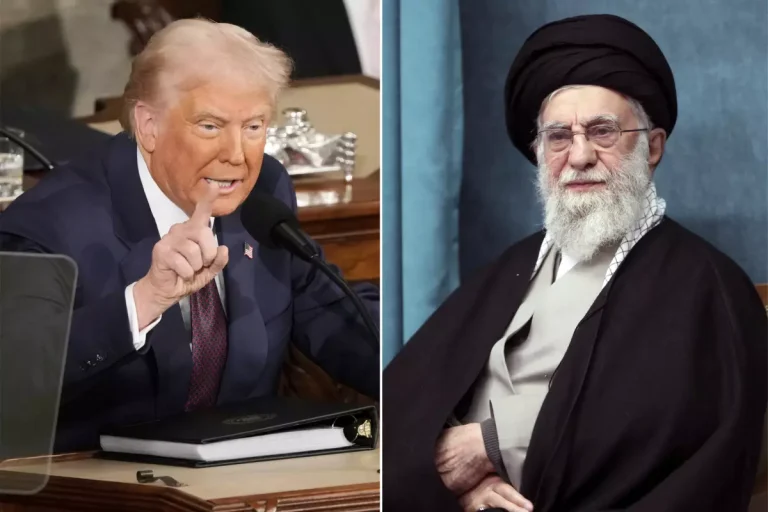DUBAI — A letter President Trump wrote to Iran’s supreme leader in an attempt to jump-start talks over Tehran’s rapidly advancing nuclear program has arrived in the Iranian capital.
While the text of the letter hasn’t been published, its arrival comes as Trump levied new sanctions on Iran as part of his “maximum pressure” campaign targeting the country. He also suggested military action against Iran remained a possibility, while emphasizing he still believed a new deal could be reached.
Iran’s 85-year-old Supreme Leader Ayatollah Ali Khamenei has mocked Trump, but officials in his country also have offered conflicting signals over whether negotiations could take place.
Here’s what to know about the letter, Iran’s nuclear program and the overall tensions that have stalked relations between Tehran and Washington since the 1979 Islamic Revolution.
Why did Trump write the letter?
Trump dispatched the letter to Khamenei on March 5, then gave a television interview the next day in which he acknowledged sending it. He said: “I’ve written them a letter saying, ‘I hope you’re going to negotiate because if we have to go in militarily, it’s going to be a terrible thing.’” Since returning to the White House, the president has been pushing for talks while simultaneously ratcheting up sanctions and suggesting a military strike by Israel or the U.S. could target Iranian nuclear sites.
A previous letter from Trump during his first term drew an angry retort from the supreme leader.
But Trump’s letters to North Korean leader Kim Jong Un in his first term led to face-to-face meetings, though no deals to limit Pyongyang’s nuclear arms development and a missile program capable of reaching the continental U.S.
How has Iran reacted?
Iran has offered a series of seemingly contradictory responses. Khamenei said he wasn’t interested in talks with a “bullying government.”
But Iranian diplomats including Foreign Minister Abbas Araghchi suggested earlier that talks over guarantees that Tehran wouldn’t seek a nuclear weapon could be possible. Araghchi, who took part in negotiations for Iran’s 2015 nuclear deal, later toughened his tone and said talks couldn’t happen under U.S. pressure, following Khamenei’s lead.
However, Araghchi still met with the Emirati diplomat carrying Trump’s letter.
Meanwhile, the Foreign Ministry on Thursday summoned ambassadors from France and Germany, as well as the British chargé d’affaires, to complain about them backing a closed-door Security Council meeting Wednesday at the United Nations.
Why does Iran’s nuclear program worry the West?
Iran has insisted for decades that its nuclear program is peaceful. Its officials increasingly threaten to pursue a nuclear weapon, however. Iran now enriches uranium to near weapons-grade levels of 60%, the only country in the world without a nuclear weapons program to do so.
Under the original 2015 nuclear deal, Iran was allowed to enrich uranium only up to 3.67% purity and to maintain a uranium stockpile of 661 pounds. The last report by the United Nations’ International Atomic Energy Agency on Iran’s program put its stockpile at 18,286 pounds as it enriches a fraction of it to 60% purity.
U.S. intelligence agencies assess that Iran has yet to begin a weapons program, but has “undertaken activities that better position it to produce a nuclear device, if it chooses to do so.”
Why are relations so bad between Iran and the U.S.?
Iran was once one of Washington’s top allies in the Mideast under Shah Mohammad Reza Pahlavi, who purchased American military weapons and allowed CIA technicians to run secret listening posts monitoring the neighboring Soviet Union. The CIA had fomented a 1953 coup that cemented the shah’s rule.
But in January 1979, the shah, fatally ill with cancer, fled Iran as mass demonstrations swelled against his rule. The Islamic Revolution followed, led by Ayatollah Ruhollah Khomeini, and created Iran’s theocratic government.
Later that year, university students overran the U.S. Embassy in Tehran, seeking the shah’s extradition and sparking the 444-day hostage crisis that would sever diplomatic relations between Iran and the U.S. In the Iran-Iraq war of the 1980s, the U.S. back Iraqi leader Saddam Hussein. The “Tanker War” during that conflict saw the U.S. launch a one-day assault that crippled Iran at sea, and the U.S. later shot down an Iranian commercial airliner.
Iran and the U.S. have seesawed between enmity and grudging diplomacy in the years since, with relations peaking when Tehran made a 2015 nuclear deal with world powers. But Trump unilaterally withdrew the U.S. from the accord, sparking years of tensions in the Mideast that persist today.
Gambrell writes for the Associated Press. AP writer Amir Vahdat in Tehran contributed to this report.



